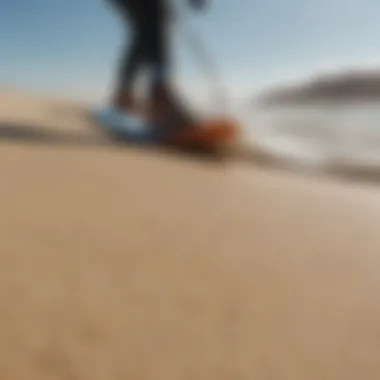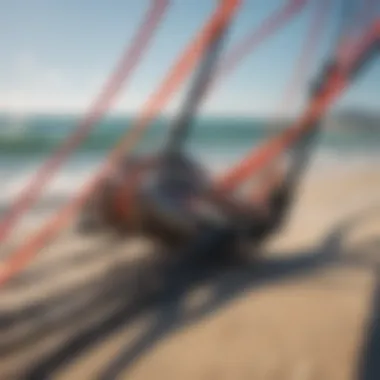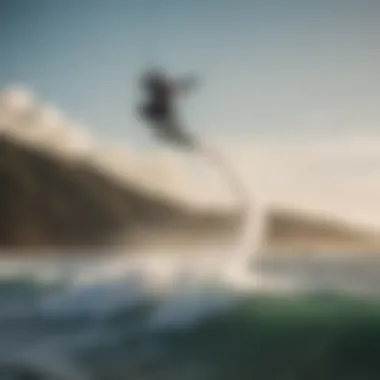Unleashing the Thrills: A Comprehensive Guide to Kiteboarding Lines


Equipment Reviews
Kites: When it comes to kiteboarding, choosing the right kite can significantly impact your performance on the water. From delta to bow-shaped kites, each design offers unique advantages in terms of wind range, depower capability, and stability. The latest kite models utilize advanced materials like Dacron, ripstop nylon, and Kevlar to enhance durability and performance. Brands such as Cabrinha, Naish, and Slingshot lead the market with innovations in kite shapes, sizes, and features.
Boards: Selecting the appropriate kiteboarding board is crucial for your riding style and preferences. Twintips are versatile and user-friendly, ideal for freestyle tricks and jumps, while directional boards excel in wave riding and carving turns. Considerations like board length, rocker profile, and fin setups determine the board's responsiveness and maneuverability. Designs from top brands like Liquid Force, Duotone, and North Kiteboarding cater to different skill levels and riding goals.
Accessories: Beyond kites and boards, essential accessories play a vital role in ensuring a safe and enjoyable kiteboarding experience. Harnesses provide crucial support and distribute kite power, enhancing rider control and comfort. Quality lines, pumps, and safety gear are essential for rigging up your kite and maintaining safety on the water. Understanding the importance of each accessory, from depower systems to quick-release mechanisms, is fundamental for kiteboarders of all levels.
Introduction
Kiteboarding lines are a critical component of the kiteboarding experience. As riders take to the water, the functionality and design of these lines play a pivotal role in maneuverability and control. This guide will delve into the nuances of kiteboarding lines, from understanding their functionality to exploring their impact on performance.
Defining Kiteboarding Lines
Understanding the Functionality
When it comes to kiteboarding, understanding the functionality of lines is essential. These lines serve as the connection between the rider and the kite, enabling precise control and responsiveness. The key characteristic of functionality lies in how well the lines transmit the rider's inputs to the kite, affecting maneuverability and power levels. Riders often opt for dynamic lines that offer a balance of strength and flexibility, enhancing the overall kiteboarding experience.
Importance in Kiteboarding Dynamics
The importance of kiteboarding lines in the dynamics of the sport cannot be overstated. These lines directly impact the way a kite behaves in the air, influencing speed, turning radius, and lift. Choosing the right lines can significantly enhance a rider's performance, making maneuvers smoother and more controlled. It's crucial for riders to understand the role lines play in optimizing their kiteboarding experience.
Evolution of Line Designs
Over the years, line designs in kiteboarding have seen significant advancements. Modern lines now incorporate innovative materials and construction techniques to improve strength, durability, and performance. The evolution of line designs allows riders to experience enhanced responsiveness and efficiency, elevating the overall kiteboarding dynamics.
Types of Kiteboarding Lines


Characteristic Differences
The various types of kiteboarding lines offer distinct characteristics that cater to different riding styles and preferences. Understanding these differences can help riders choose lines that align with their performance goals and skill level. Factors such as material strength, stretch elasticity, and diameter all influence how a line performs in different conditions.
Pros and Cons of Various Line Types
Each type of kiteboarding line comes with its own set of advantages and disadvantages. Whether riders opt for spectra, dyneema, or another material, weighing these pros and cons is crucial. Factors like weight, durability, and water resistance can impact a rider's experience on the water.
Impact on Performance
The type of line used in kiteboarding has a direct impact on overall performance. Factors such as line stretch, rigidity, and weight can affect maneuverability, power control, and responsiveness. By choosing lines that enhance performance, riders can elevate their skills and enjoy a more dynamic kiteboarding experience.
Materials Used in Kiteboarding Lines
Nylon vs. Dyneema: A Comparison
Nylon and dyneema are two popular materials used in kiteboarding lines, each offering unique characteristics. Nylon lines are known for their stretch and durability, while dyneema lines excel in strength and low stretch properties. Understanding the differences between these materials is crucial in selecting lines that align with individual riding preferences.
Durability and Flexibility Factors
When it comes to kiteboarding lines, durability and flexibility are key considerations. Riders need lines that can withstand the rigors of kiteboarding while offering the necessary flexibility for fluid movements. Balancing durability with flexibility ensures optimal performance and longevity of the lines.
Environmental Considerations
Environmental factors also play a role in determining the ideal kiteboarding lines. From UV resistance to saltwater corrosion, lines are exposed to various elements that can affect their lifespan. Choosing lines that are environmentally friendly and resistant to deterioration ensures a sustainable and long-lasting kiteboarding setup.
Line Lengths and Their Significance


Effects on Power Control
Line lengths play a crucial role in power control during kiteboarding. Longer lines tend to offer greater power and wind range, ideal for riders seeking stronger gusts and higher jumps. On the other hand, shorter lines provide faster turning speeds and enhanced control in dynamic conditions. Understanding the effects of line lengths is essential for optimizing power control on the water.
Optimal Length Recommendations
Finding the optimal line length for kiteboarding is a balancing act between power, control, and maneuverability. Recommendations vary based on riding style, wind conditions, and experience level. By following guidelines for optimal line lengths, riders can fine-tune their kiteboarding setup to maximize performance and responsiveness.
Adjusting Line Lengths for Conditions
Adjusting line lengths based on changing conditions can significantly impact a rider's experience on the water. Shortening lines in higher winds can boost control and stability, while lengthening lines in light winds can enhance power and efficiency. Knowing how to adjust line lengths according to conditions is crucial for adapting to variable environments.
Ensuring Line Integrity and Maintenance
Regular Inspection Practices
Maintaining line integrity is key to a safe and enjoyable kiteboarding session. Regular inspections help identify wear and tear, abrasions, or knots that can compromise line strength. By regularly inspecting lines for damage and weakness, riders can prevent accidents and ensure optimal performance on the water.
Repair Techniques
In the event of line damage, knowing effective repair techniques can save a session from being cut short. Repairing knots, splices, or frays promptly can extend the lifespan of lines and maintain their performance. Understanding and applying proper repair techniques is essential for keeping lines in top condition.
Storage Tips
Properly storing kiteboarding lines is crucial for preserving their quality and longevity. Coiling lines neatly, avoiding direct sunlight exposure, and rinsing lines with freshwater after use are essential practices. By following storage tips, riders can prolong the lifespan of their lines and maintain peak performance over time.
Enhancing Performance Through Line Adjustments


Tuning for Wind Conditions
Adapting line setup to wind conditions can significantly enhance performance on the water. Tuning lines for different wind speeds and directions optimizes power delivery, maneuverability, and responsiveness. Fine-tuning line settings based on wind dynamics ensures a more controlled and dynamic kiteboarding experience.
Fine-Tuning Handling
Fine-tuning line handling involves adjusting line tensions, angles, and positions to fine-tune a kite's behavior. By customizing handling to personal preferences and riding styles, riders can achieve smoother turns, enhanced stability, and improved control. Fine-tuning handling is a personalized process that maximizes performance on the water.
Customizing Setup for Tricks
Customizing line setups for tricks adds a layer of personalization and creativity to kiteboarding. Tailoring line configurations to specific tricks or maneuvers can enhance execution, precision, and style. Whether adjusting line lengths, tensions, or angles, customizing setup for tricks allows riders to showcase their skills and creativity on the water.
Safety Measures and Line Management
Avoiding Line Tangles
Preventing line tangles is essential for a safe and uninterrupted kiteboarding session. Proper line management, clear communication with other riders, and strategic body movements can help reduce the risk of entanglements. By avoiding line tangles, riders can minimize accidents and distractions on the water.
Emergency Release Systems
Having reliable emergency release systems in place is crucial for rider safety in emergency situations. Quick-release mechanisms, safety leashes, and timely actions can prevent accidents and injuries during kite malfunctions or crashes. Understanding and practicing the use of emergency release systems is paramount for ensuring rider safety.
Dealing with Line Breakage
In the event of line breakage, knowing how to react swiftly and effectively is essential. Dealing with line breakage requires maintaining control of the kite, assessing the situation, and initiating emergency procedures. By staying calm and following protocols, riders can manage line breakage scenarios safely and avoid accidents on the water.
Conclusion
Kiteboarding lines are not just ropes connecting you to your kite; they are essential components that influence your performance and safety on the water. Understanding the intricacies of line types, materials, lengths, and maintenance is vital for honing your skills and maximizing your enjoyment of the sport. By incorporating the insights and tips provided in this guide, kiteboarders can optimize their setups, enhance their performance, and elevate their overall kiteboarding experience.
Final Tips for Line Optimization
- Regularly inspect lines for wear and tear to ensure safety and longevity.
- Practice proper line management techniques to prevent tangles and accidents.
- Adjust line lengths and setups according to wind conditions for optimal performance.
- Invest in high-quality lines made from durable and reliable materials for lasting performance.
- Stay informed about the latest advancements in line technology to enhance your kiteboarding setup.







